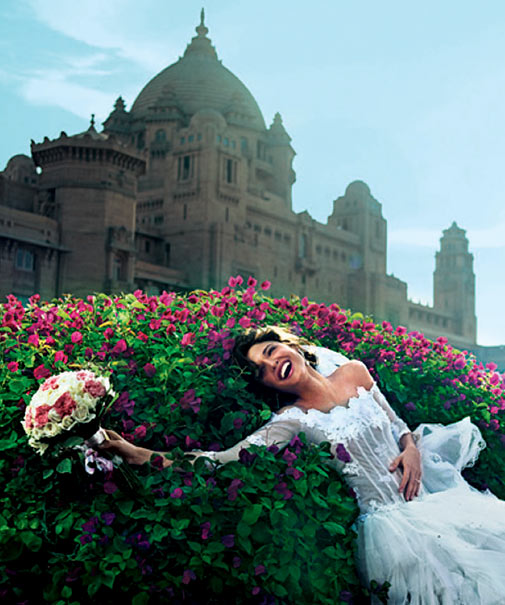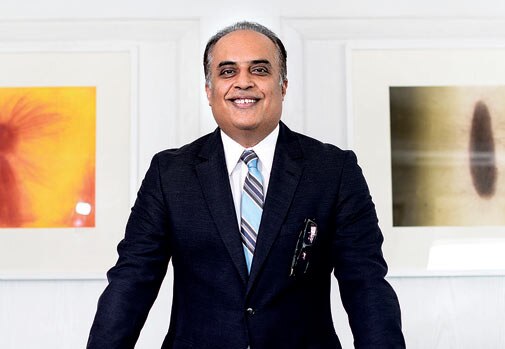
A lovely waterfront retreat in Goa with a private motor yacht moored to the sides, a large eclectic art collection, a house in Delhi's tony Sundar Nagar and a farmhouse in the making at Chhattarpur. On the surface, Arjun Sharma, the 48-year-old Chairman of Select Group, who takes exotic holidays with his wife, former model Jyotsna Sharma, and wears designer wear with elan, seems to be surrounded by all the trappings that money can buy. But beneath that luxurious veneer lie the odd twinges of discomfort. For a man who promotes material spending in a big way - he runs the happening Select City Walk mall in Delhi - Sharma talks about the need to cut back. "It may sound like a contradiction when I say it. But the consumption story has to come down," he says.
To conquer his guilt every time he buys something new, he says, he gives away two. He and his wife fund a large number of charities - and his travel company Le Passage to India has a wing called Shaping Lives devoted to volunteer tourism. He talks passionately about organic food, and, pointing to the art on his walls, says he never buys extravagantly-priced works, but promotes newer artists. His new home in Chattarpur will be eco-friendly with active ceramic tiles that absorb pollution and solar panels that minimise energy consumption. "I want to give my family some intergenerational equity - clean air, clean water, clean energy," he says.
New Boys on the Block
Sharma is one example of the emerging new wealthy consumer for whom luxury is necessary, but pompous splendour is not. But there are others treading different consumption paths. Just last month, at the wedding of a scion of a top industrialist in NCR, the liquor bill alone ran into Rs 1 crore, with the most expensive of all champagnes (Louis Roderer Cristal) uncorked and pricey single malts flowing like water.
Then, there are the CEOs of young e-commerce start-ups who have suddenly come into millions with venture funding and can be seen zipping around in Mumbai and Bangalore in their newly-acquired BMWs. In Delhi, young lawyers can also be seen in flashy Audis, lunching at fine dining outlets at Cyber Hub, and partying in the evening at five star bars.

Dilip Puri, Managing Director, India of Starwood Hotels & Resorts, which will be launching its poshest hotel St. Regis in India next month, admits: "People are changing in what they want from a luxury standpoint today." Puri says most people today want experiences, there is a focus on restraint, discretion and privacy.

After meeting a wide spectrum of people in the luxe business, both consumers as well as marketers, we have pinpointed six new drivers of luxury today in the Indian market.
Thoughtful Luxury

One Size No Longer Fits All
Luxury brands that so far had to deal with a fairly homogenised group of customers are suddenly finding that they have to innovate and segment far more. The assumptions that luxury could only be afforded by a slightly older profile wanting timeless elegance are getting shattered. A decade ago, the luxury consumer base was made up of just two classes - there was old money which went in for classy elegance and there was new money generated from trade that went for flashy opulence. Today, there is far more segmentation in the profile of the luxe customer. A lot of millennials are now becoming consumers of luxury and their tastes are quite different, besides which they are aware, shrewd consumers. They are open to experimentation and, unlike the older set, who were once-an-Armani-loyalist-always-one, don't mind switching brands. Also, people, young and old alike, are now becoming comfortable with the idea of spending money, says Dinaz Madhukar, Vice President, DLF Luxury Retail quoting what a luxe customer told her. "Money in the bank when you die means you have not enjoyed life."
"The young want drama," says Archana Kumari, President, India of Frazer and Haws, a vintage silver accessories brand that entered India in 1991. So, Frazer and Haws, which is identified with its Victorian tea sets and old salvers, is today doing very bold fusions, mixing materials. For instance, it has created a line of dramatic artefacts by embossing silver designs on imported Murano glass products. It has experimented with pairing terracotta and silver. "The younger audience are reckless, they want cool - they come to our stores and say we don't want similar looking watches year after year. We have some classic timepieces, but the young want something different," says Puneet Sewra, Marketing Director, Tag Heuer. This led to the company's tie-up with supermodel Cara Delevigne and the creation of an exotic line in black - big black dials studded with black diamonds. At the back of the watch is a lion tattoo, one that adorns Cara's fingers.
Almost every brand has to expand its designs to fit in to more tastes. As Frederique Constant's India Director Arun Marc D'Silva says: "One has to position the brand in a space that appeals to a specific target audience."
Bridge Luxury Rules

However, what is growing in India is bridge luxury or affordable luxury. Says Puneet Sewra, Marketing Director, Tag Heuer, "We are not seen as a brand where you have to spend a crore. And, that has played to our advantage"

Ditto for Danish audio video products player Bang and Oluffsen. It is trying to capture the affordable luxury market by marking down prices. Gaganmeet Singh, Managing Director, Beoworld, says prices in India are 10-15 per cent cheaper and the company is discounting this by taking it out of its marketing spends. Also, he says, the brand has products running up to Rs 50 lakh (TV etc) has just launched an affordable vertical called BeoPlay where prices are between Rs 10,000 and Rs 2.5 lakh.
For the brands that have chosen to ladder down, the gains are immediately visible and you can see how upbeat they are, but several uber luxe brands are hesitating as they don't want to end up making their products too democratic. Of course, creating limited editions is one way to keep some of the brands products exclusive. It's quite an interesting story playing out there as brands decide on their strategies.
Chanting the Wedding Mantra
The HNIs may be showing restraint in other things, but when it comes to weddings, opulence rules. There are at least 500 weddings a year where the spends are over Rs 10 crore says Vivek Ramabhadram, MD, Swarovski India.



Gaurav Bhatia, Market-ing Director, Moet Hennessy India, says: "Make in India is becoming bigger and bigger. Seeing the evolution of a young and dynamic Indian, companies like Moet Hennessy have invested in and created a brand like Chandon made in India, for India." This approach kills a lot of birds with one stone. It nullifies the crippling import duty structure that stifles the growth of the luxury market, it appeals to the tastes and sensibilities of the Indian market and also allows the luxury brand to create a more affordable product to woo a wider set of people. For instance, Moet Hennessy's Chandon made in India is priced at Rs 1,200. Of course there are challenges. Louis Vuitton has had to close its Pondicherry unit, but for every LV there are two or three other brands setting up manufacturing shops here.

Its All About Experiential
Luxury today is shifting rapidly from "having" to "being" - from owning a product to experiencing a luxury, says the BCG report, Shock of the New Chic. According to the report, the Millennial generation - those in their 20s are geared to pleasure rather than possessions. To these young people, owning something usually comes second to sharing new ideas and new experiences. It's also true of the older HNIs, who after surrounding themselves with a plethora of luxe products are now looking for novel experiences. Which is why product companies are also trying to create experiences. So luxury spirits makers have fine drinking sessions or wine socials. Almost every luxe car maker today has gone in for experiential retailing, laying out the wine and cheese. The business of luxury experiences - from private airline services to five-star restaurants - is growing very rapidly, and is already worth almost $1 trillion of the total luxury market of $1.8 trillion global luxury market, says the BCG report.
There are some other encouraging triggers as well - the digital play, for instance. Luxury brands were relatively late to the digital party - but are now suddenly finding the huge power of social media. It's a great fit because luxury rarely advertises and works on the power of word of mouth.
GETTING HOUSEPROUD

The story of luxury is interesting, says Rudra Chatterjee, Chairman, Obeetee Carpets. When people first start consuming luxury they only go after what impresses others, but gradually, as luxury becomes part of their lives, they start incorporating it in their homes, in daily living.
People are now looking to entertain at their homes a lot more, says Adarsh Jatia, managing Director of Provenance Lands, which is creating the Four Seasons branded residences, describing how they have created areas where private dinners for 10 can be arranged or a celebration for 300 guests on the rooftop lounge of the apartments. Agrees Arjun Sharma: "It's really about more personalised entertaining at home." He describes how banks are now arranging top chefs for their ultra HNI clients to entertain at home. Obviously, then homes are getting a lot of attention. So, from luxe carpets, furniture and lighting to luxe speakers and smart television sets, home accessories are witnessing an uptick. Dinaz Madhukar describes how at the Emporio she has noticed that most designers have added a home line in addition to their couture range. "Today homes are reflective of the growing aspirations of people and exemplifies their taste and lifestyle. The luxury lighting market today is about Rs 350 crore in India, a key segment of which is residential lighting," says Harsh Chitale, CEO, Philips Lighting, South Asia, describing why Philips decided to introduce its international luxury brands - Luceplan and Modular - in India.